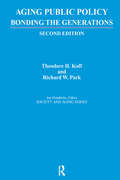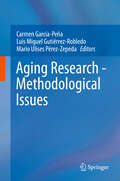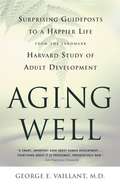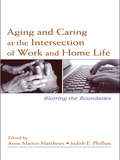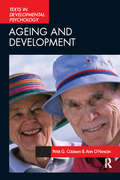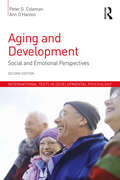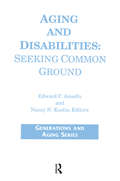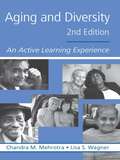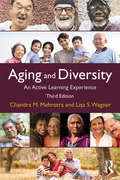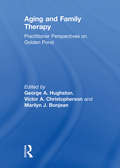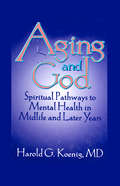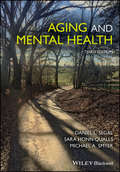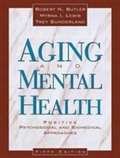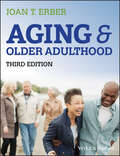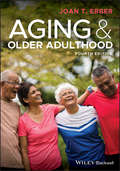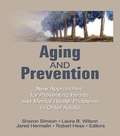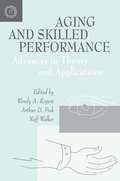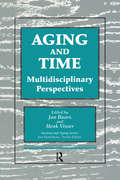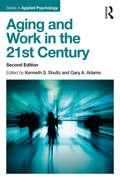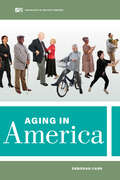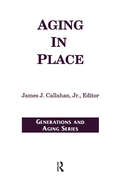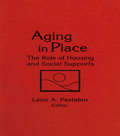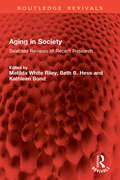- Table View
- List View
Aging Public Policy: Bonding the Generations (Society and Aging Series)
by Theodore H. Hoff Richard W. Park"Aging Public Policy: Bonding the Generations" is presented in three parts. Part One describes the policy process as a response to human needs through the laws of our country. Part Two explores the national policy development on behalf of older persons. Part Three describes the major public policies on behalf of the elderly that include Social Security, Medicare, The Older Americans Act, institutional care, employment and retirement policies. The final chapter discusses the advocacy process in the field of aging.
Aging Research - Methodological Issues
by Carmen García-Peña, Luis Miguel Gutiérrez-Robledo and Mario Ulises Pérez-ZepedaThis book reviews classical epidemiological and clinical research studies, with a focus on aging. Chapters cover methodological topics like the scientific method, ethics, and the consequences of certain exclusion criteria and the work includes a look at clinical concepts like multi morbidity, frailty and functionality. The authors reveal the issues and challenges for researchers of age and aging, and also consider the translation of scientific knowledge, from basic to clinical and from clinical to public policies of social and health care.The focus on aging is what gives this book its valuable perspective on research methodology. All authors have considerable experience in aging, geriatrics or gerontology and each chapter includes both a theoretical framework and practical examples of studies in aging. Readers will discover study designs that are reviewed for basic structure, main flaws and advantages and are analyzed for specific conditions and variables regarding aging.This text is suited to both health care professionals caring for older adults and researchers who are new to research in aging. It is relevant across the disciplines, including medicine, psychology, social sciences and dentistry and it supports learning with graphs and figures.
Aging Well: Surprising Guideposts to a Happier Life from the Landmark Study of Adult Development
by George E. VaillantThis is the acclaimed bestseller that reveals the scientific secrets to ensuring that our golden years are truly golden. Based on the longest and most complete study of adult development in the world, Aging Well draws from the individual histories of 824 men and women from a variety of backgrounds to illustrate the most important factors involved in reaching and enjoying a happy, healthy old age.
Aging and Caring at the Intersection of Work and Home Life: Blurring the Boundaries
by Anne Martin-MatthewsThere are not many books that address the boundaries of care of older people from a work-life perspective. This book, authored by contributors from various countries, looks at the boundaries of care by looking at private and public help, professional and personal help and paid and unpaid caregivers. It captures and conceptualizes the complexity of the intersection of work and home life as it relates to the provision of assistance and support to older relatives in a variety of "care work" contexts. It explores these issues within a critical framework, rather than from an assumed stress or burden perspective, which dominates current texts on the topic. Readers of this volume will gain a deeper understanding of issues of care provision amongst "networks" of careers and helpers, and of the particular dynamics of care when it is episodic or framed by constrains of space and time as a result of geography. In addition, each chapter addresses issues of diversity with sensitivity to gender, race and ethnicity. This book will be of use to academics and graduate students in Gerontology, Family Studies, IO psychology, Gender Studies and Sociology.
Aging and Development: Social and Emotional Perspectives (International Texts in Developmental Psychology)
by Peter Coleman Ann O'HanlonWith increasing numbers of the population living into old age, we need a better understanding of the nature and experience of ageing in all its aspects. Up to now, very few texts have considered this in any depth, but 'Ageing and Development', a new volume in the Texts in Developmental Psychology series, provides a detailed and comprehensive overview of the theories and research in adult development into old age. The classic early accounts of theorists such as Jung and Erikson are considered, as well as their present day successors. Particular attention is given to theories of adjustment to loss, and to the threat of loss, which dominate current gerontological research.A notable feature of the book is the separate section devoted to the psychology of advanced old age, to life in states of physical and/or mental frailty, and to the survival of the self in these circumstances. There is a strong emphasis throughout on up-to-date empirical research and illustrative case examples. The reader is constantly encouraged to take a critical perspective, to understand the strengths and limitations of different studies, and to think about the issues raised in terms of their own lives.
Aging and Development: Social and Emotional Perspectives (International Texts in Developmental Psychology)
by Peter G. Coleman Ann O'HanlonThe psychology of aging usually focuses upon cognitive changes, with a particular focus on dementia and other forms of cognitive decline. But getting older is about more than simply changes to the brain and related health issues. Changes to our social and emotional lives are also hugely significant as we adapt across our lifespan. The second edition of Aging and Development is the only textbook available that responds to the growing interest in social, personal and emotional development in older age. Ideally suited to complement texts on cognitive change, the book provides a holistic developmental perspective on aging. It highlights a range of issues, including the development of personal meaning and spirituality, improvements in emotional control, uses of reminiscence and life review, the importance of healthy attitudes to aging, as well as the maintenance of close personal relationships. It does not avoid the difficult issues of late life decline, but illustrates how even in circumstances of physical and mental frailty a positive sense of self can be created and enhanced. Fully updated to provide the most cutting-edge overview on this burgeoning topic of interest, Aging and Development includes a glossary and list of useful websites both on the study of gerontology and the psychology of aging. It will be essential reading for all students of developmental psychology, as well as anyone either training to work or already working with older people.
Aging and Developmental Disability: Current Research, Programming, and Practice Implications
by Joy Hammel Susan NochajskiAging and Developmental Disability: Current Research, Programming, and Practice Implications explores research findings and their implications for practice in relation to normative and disability-related aging experiences and issues. This valuable book discusses the effectiveness of specific interventions targeted toward aging adults with developmental disabilities such as Down's Syndrome, cerebral palsy, autism, and epilepsy, and offers suggestions for practice and future research in this area.
Aging and Disabilities: Seeking Common Ground
by James J CallahanThis book helps in ...building a bridge between the networks...The topics of aging and disabilities are multifaceted and therefore may be approached in many ways. The editors have chosen to focus on four systems and areas of common ground (aging, developmental disabilities, independent living movement, and rehabilitation), to investigate the emerging "intersection" of the two fields.
Aging and Diversity
by Stephen Fried Lisa S. Wagner Chandra M. MehrotraThis new edition has been completely rewritten and includes chapters that address key topics in diversity and aging: research methods, psychological aging; health beliefs, behaviors, and services; health disparities; informal and formal care for older persons; work and retirement; religious affiliation and spirituality; and death, dying, and bereavement. Taking a broad view of diversity, Mehrotra and Wagner discuss elements of diversity such as gender, race or ethnicity, religious affiliation, social class, rural-urban community location and sexual orientation. Including these elements allows them to convey some of the rich complexities of our diverse culture - complexities that provide both challenges to meet the needs of diverse population and opportunities to learn how to live in a pluralistic society. Throughout the book, Mehrotra and Wagner present up-to-date knowledge and scholarship in a way that engages readers in active learning. Rather than simply transmitting information, the authors place ongoing emphasis on developing readers' knowledge and skills; fostering higher order thinking and encouraging exploration of personal values and attitudes. Distinctive features of the book include: Opening vignettes for each chapter that present a sampling of how the issues to be discussed apply to diverse elders. Active learning experiences that invite readers to interview diverse elders, conduct internet searches, and give an analysis of a case study. Quizzes at the end of the chapters help readers ascertain the extent to which they have learned the material; the key for each quiz includes details about correct and incorrect responses so that additional learning can occur. Aging and Diversity Online boxes interspersed throughout the book provide internet resources that readers may use to find new research and publications. Suggested readings and audiovisual resources given at the end of each chapter serve as a guide to additional information on topics covered in the chapter. This approach of presenting the material will help the readers understand and apply key concepts and principles in ways that will not only improve the lives of older people they serve, but will also enhance their own aging experience.
Aging and Diversity: An Active Learning Experience
by Chandra Mehrotra, Ph.D. Lisa Smith WagnerAs the older population in the United States is becoming more racially and ethnically diverse, it is important to understand the characteristics, the potential, and the needs of this population. In this new and fully revised edition of Aging and Diversity, Chandra Mehrotra and Lisa Wagner address key topics in diversity and aging, discussing how the aging experience is affected by not only race and ethnicity but also gender, religious affiliation, social class, rural-urban community location, and sexual orientation and gender identity. Taking this broad view of human diversity allows the authors to convey some of the rich complexities facing our aging population – complexities that provide both challenges to meet the needs of a diverse population of elders and opportunities to learn how to live in a pluralistic society. Mehrotra and Wagner present up-to-date knowledge and scholarship about aging and diversity in a way that engages readers in active learning, placing ongoing emphasis on developing readers’ knowledge and skills, fostering higher order thinking, and encouraging exploration of personal values and attitudes.
Aging and Family Therapy: Practitioner Perspectives on Golden Pond
by George Hughston Victor Christopherson Marilyn BojeanEnhance the intervention strategies you use in therapy with older adults and their families. This significant new book provides practitioners with information, insight, reference sources, and other valuable tools that will contribute to more effective intervention with the elderly and their families. Outstanding scholars have contributed original material that addresses the major issues in treating the elderly from the practitioner’s point of view; the biological, psychological, social, and spiritual concerns of the aged are examined in order to formulate a systemic and comprehensive treatment plan. Destined to become a classic in a challenging new area of psychotherapy, the unique Aging and Family Therapy promises to guide and inform practitioners who will be called upon to provide assistance to the increasing number of older adults who will be in need of mental health services.
Aging and God: Spiritual Pathways to Mental Health in Midlife and Later Years
by William M Clements Harold G KoenigThis important book examines the relationship between religion and mental health throughout the life cycle, with a special emphasis on later life. It asserts that successful aging is possible regardless of physical health or environmental circumstances, and that religious beliefs and behaviors may facilitate successful aging. Aging and God thoroughly examines the effects of religion and mental health on aging and provides a centralized resource of up-to-date references of research in the field. It focuses on recent findings, theoretical issues, and implications for clinical practice and contains ideas for further research. In Aging and God, you’ll also find information on project design that can help you develop grant applications and carry out studies.Aging and God is a helpful book for both mental health and religious professionals. It helps mental health specialists better understand the spiritual needs of older adults and the impact that religion can have on facilitating mental health. It also describes how religion can be utilized in clinical practice and integrated into psychotherapeutic approaches to older patients. The book brings religious professionals current knowledge of the major psychological problems that older adults face and how religion can be used to help alleviate these problems.Full of pertinent information, Aging and God addresses theoretical aspects of human development, focusing on cognitive, moral, and religious faith development examines situations and disorders of particular concern to older persons and looks at how religion can be used as a resource applies research findings to the problem of meeting the spiritual and mental health needs of elders with chronic or acute health problems provides an in-depth look at end-of-life issues such as physician-assisted suicideHospital and nursing home chaplains will find this book informative and encouraging, as will gerontologists, hospital administrators, and community clergy faced with increasingly older congregations. It gives mental health professionals new strategies to help improve the later years of older adults, and makes an excellent text for courses on religion, mental health, and aging. Middle-aged and older adults, as well as their families, will also find Aging and God enjoyable and inspiring as they attempt to grapple with the myriad adjustment and coping problems associated with aging.
Aging and Mental Health (Understanding Aging)
by Daniel L. Segal Sara Honn Qualls Michael A. SmyerFully updated and revised, this new edition of a highly successful text provides students, clinicians, and academics with a thorough introduction to aging and mental health. The third edition of Aging and Mental Health is filled with new updates and features, including the impact of the DSM-5 on diagnosis and treatment of older adults. Like its predecessors, it uses case examples to introduce readers to the field of aging and mental health. It also provides both a synopsis of basic gerontology needed for clinical work with older adults and an analysis of several facets of aging well. Introductory chapters are followed by a series of chapters that describe the major theoretical models used to understand mental health and mental disorders among older adults. Following entries are devoted to the major forms of mental disorders in later life, with a focus on diagnosis, assessment, and treatment issues. Finally, the book focuses on the settings and contexts of professional mental health practice and on emerging policy issues that affect research and practice. This combination of theory and practice helps readers conceptualize mental health problems in later life and negotiate the complex decisions involved with the assessment and treatment of those problems. Features new material on important topics including positive mental health, hoarding disorder, chronic pain, housing, caregiving, and ethical and legal concerns Substantially revised and updated throughout, including reference to the DSM-5 Offers chapter-end recommendations of websites for further information Includes discussion questions and critical thinking questions at the end of each chapter Aging and Mental Health, Third Edition is an ideal text for advanced undergraduate and graduate students in psychology, for service providers in psychology, psychiatry, social work, and counseling, and for clinicians who are experienced mental health service providers but who have not had much experience working specifically with older adults and their families.
Aging and Mental Health: Positive Psychosocial and Biomedical Approaches
by Robert N. Butler Myrna I. Lewis Trey SunderlandDesigned for professionals working with the elderly, this text provides comprehensive coverage of the ageing process and its effects on mental health. It sets out the nature and problems of old age, including the problems of older people in their families, and explores some of the common emotional problems and psychiatric disorders which can affect the elderly. It also outlines the evaluation, treatment and prevention of some common effects of ageing. There is specific coverage of race, ethnicity, gender, crime, alcoholism and physical disabilities, including deafness and blindness.
Aging and Older Adulthood (Wiley Desktop Editions Ser.)
by Joan T. ErberThe third edition of this essential text has been updated and expanded with new material that reflects the most recent developments in the field, and explores our current understanding of a broad range of topics related to aging and older adulthood. Fresh edition includes updated content such as revised case histories and reworked material on key concepts and research applications Retains the winning format of the second edition, with chapter contents framed by individual histories Dual models add cohesiveness to the presentation of theory Thematic structure facilitates reader comprehension Instructor resources provided online upon publication at www.wiley.com/go/erber
Aging and Older Adulthood (Wiley Desktop Editions Ser.)
by Joan T. ErberReflects the most important theoretical foundations and research directions concerning aging and older adulthood This authoritative volume provides the latest insights into, and theoretical interpretation of, our understanding of the human aging process. Newly updated and revised, this edition of the well-established student textbook offers relatable scenarios that touch upon real-world issues faced by older adults and their families. The book explains how research studies attempt to answer questions of both theoretical and practical importance as they relate to aging and older adulthood, and it explains the hypotheses and findings of the studies in a manner that is comprehensible to readers of all levels of research experience. Aging and Older Adulthood begins by describing the demographic characteristics of the older population, and follows with a chapter on theoretical models that apply to the study of adult development and aging, as well as approaches commonly taken to conduct research and ethical concerns involved in the study of this group. It then offers a series of chapters exploring biological aging, sensation perception and attention, memory, intellectual functioning, cognition and real-world problem-solving, personality and coping, social interaction and social ties, lifestyles and retirement, mental health and psychotherapy, and death and bereavement. The final chapter looks at aging in the future. Each chapter includes fully updated research findings, as well as new and expanded coverage of concepts and ideas in areas such as neuroscience, and diabetes. New edition of a highly respected text exploring our contemporary understanding of a broad range of topics related to older adulthood and the psychology of aging Offers thematic treatment of core issues including health, sensory perception, memory, intellect, social interactions, employment and retirement, and mental health Uses a dual lens of two models – the selective optimization with compensation model and the ecological model – to provide cohesiveness to the presentation of both theoretical and applied material Introduces each chapter with a relevant real-world scenario and refers back to it throughout the chapter Includes pedagogical feature boxes that reflect current understanding of contemporary issues in the field as well as key points and issues for further discussion Aging and Older Adulthood, 4th Edition is an excellent text for upper division undergraduate and graduate courses focusing on the older adulthood and aging, the psychology of aging, gerontological studies, and lifespan development.
Aging and Prevention: New Approaches for Preventing Health and Mental Health Problems in Older Adults
by Robert E HessRenowned specialists on aging explore the meaning of prevention and provide practical information about programs and services for the elderly. Interesting chapters focus on the prevention of long-term care institutionalization, alternative health delivery systems, informal support networks, and the prevention of domestic neglect and abuse of elderly adults.
Aging and Skilled Performance: Advances in Theory and Applications
by Wendy A. Rogers Arthur D. Fisk Neff WalkerThe term "skill" encompasses an array of topics and issues. For example, individuals are skilled in a variety of domains such as chess, typing, air traffic control, or knitting; researchers study skill in a variety of ways, including speed of acquisition, accuracy of performance, and retention over time; and there are a variety of approaches to the study of skill such as computer modeling or experimental analysis. Contributing to the understanding of whether, how, when, and why skills may decline as a function of age is the goal of this volume. This book is based on the Aging and Skill Conference sponsored by the Center for Applied Cognitive Research on Aging. The broad focus of the conference was to discuss cognitive theories underlying age-related skill acquisition, transfer, and retention and to discuss applications of these theories to such issues as age-adaptive training, compensatory strategies and devices, and utilization of new and existing technology. The contributors were asked to discuss the cognitive theory relevant to their topic, explain how the theory informs the field about aging, examine where gaps exist among general cognitive theory in this area and theories of aging, and demonstrate the practical relevance of the theory to enhancing or enabling activities of daily living--for work, home, or leisure--for older adults. This is the first book to focus exclusively on aging and skill. It covers a range of abilities, provides the theoretical basis for the current status of age-related differences in skill, and offers direct evidence of the applicability of research on proficiency to aspects of daily living. Each chapter was written either by an expert in the field of aging, or by an expert in the field of skill--many expert in both areas.
Aging and Time: Multidisciplinary Perspectives, Illustrated Edition
by Jan BaarsThe aim of this volume is to revitalise the debate about the concepts of time implicit in the study of aging. The many problems related to aging and the aged put an enormous pressure on the gerontological community to come up with practical applications and solutions. In considering research findings, we must keep in mind the basic assumptions that shape and influence even the most obvious statements about aging. In this multidisciplinary volume, the contributors take on the important task of exploring real issues concerning temporal concepts and approaches to aging; and the concepts of time that are used in thinking about aging determine to a large extent the way aging is approached. Most studies of aging still use a chronological approach to define populations for research purposes (that is, to determine which "aged" should be studied) and to establish how people's characteristics (social, economic, health and so forth) change as a function of age. This approach may lead to an accumulation of data, but does not in itself lead to explanatory knowledge. The step from chronological time to chronological age should be taken cautiously if we want to consider aging processes seriously, especially because chronological age is widely used in contemporary societies as a basis for regulating all kinds of processes, with many consequences for individuals. The arguments presented here do not deny the finitude of human life, nor do they deny that "aging" can be observed in any individual if we compare the characteristics of that person over a relatively long period. The question is how to approach these themes to get a better understanding. To achieve this, we need to understand the specific significance and relativity of chronological time and uncover unfounded deductions about time in relation to aging. This book will be of interested to students and professors of the social sciences, humanities and aging, including the methodology of aging studies; professionals working in the field of aging, including sociologists, psychologists and biologists.
Aging and Work in the 21st Century (Applied Psychology Series)
by Kenneth S. Shultz Gary A. AdamsAging and Work in the 21st Century, 2nd edition, reviews, summarizes, and integrates existing literature from various disciplines with regard to aging and work, but with a focus on recent advances in the field. Chapter authors, all leading experts within their respective areas, provide recommendations for future research, practice, and/or public policy. Fully revised and updated, the second edition takes up many of the same critical topics addressed in the first edition, and incorporates twelve new authors across the volume and three brand new chapters on recruitment and retention, legal issues, and global issues in work and aging. The intended audience is advanced undergraduate and graduate students, as well as researchers in the disciplines of industrial and organizational psychology; developmental psychology; gerontology; sociology; economics; and social work. Older worker advocate organizations, such as AARP, will also take interest in this edited book.
Aging in America (Sociology in the Twenty-First Century #8)
by Deborah CarrThe aging of America will reshape how we live and will transform nearly every aspect of contemporary society. Renowned life course sociologist Deborah Carr provides a lively, nuanced, and timely portrait of aging in the United States. The US population is older than ever before, raising new challenges for families, caregivers, health care systems, and social programs like Social Security and Medicare. Organized in seven chapters, Aging in America covers these topics: the history of aging and the development of theoretical approacheshow cultural changes shape our views on agingthe demographic characteristics of older adults todayolder adults' family lives and social relationshipsthe health of older adults and social disparities in who gets sickhow public policies affect the well-being of older adults and their familieshow baby boomers, Gen Xers, and millennials will experience old age Drawing on state-of-the-art data, current events, and pop culture, this portrait of an aging population challenges outdated myths and vividly shows how future cohorts of older adults will differ from the generations before them.
Aging in Place (Generations And Aging Ser.)
by James J. Callahan"Aging in place" is among the newer terms to be included along with "senior citizen," "golden agers," and others in the lexicon of gerontology. Since aging is a lifelong process and each of us occupies three-dimensional space, we are, of course, always aging in place, but two factors have caused aging in place to emerge as a salient concern for gerontological policy makers. The first is the explosive growth of homeownership after World War II, the other is the perception that thousands of older people have been flowing into nursing homes unnecessarily when they can and should remain in their own home or apartment.
Aging in Place: Designing, Adapting, and Enhancing the Home Environment
by Jodi Carlson Ellen D TairaProvide a comfortable living environment for the aging!Aging in Place: Designing, Adapting, and Enhancing the Home Environment gives you a complete examination of current trends in adaptive home designs for older adults. As a therapist, designer, architect, builder, home planner, social worker, community organizer, or gerontologist, Aging in Place will show you innovative home designs and studies for creating environments that offer optimal living for aging adults. Complete with diagrams, floor plans, and tables, Aging in Place helps you to improve the quality of life for the elderly by offering them state-of-the-art designs that encourage independence and dignity. This unique and exciting book covers topics such as universal design which strives to create everyday environments and products like door handles and light switches that are usable by all people to the greatest extent possible, regardless of age or ability. Aging in Place will also show you how to: use follow-up visits by occupational therapists to ensure successful use of home modifications create environments that are helpful for vision rehabilitation by using controlled lighting and color schemes evaluate the quality of life for elderly people living in personal dwellings, specialized housing, and nursing homes explore architectural barriers and the uses of helping devices for elderly people examine research critiques of adaptive toilet equipment investigate modifications that have been made in homes for the elderly in India analyze ways in which elderly people have changed their homes to make the telephone more accessibleAging in Place is a complete guide to understanding the needs and latest trends in optimizing the living space of elderly persons. The book gives you access to several studies on elderly people's environmental needs and preferences in regard to modifications in personal and public dwellings. This information will assist you with better serving the elderly by helping them live more independently.
Aging in Place: The Role of Housing and Social Supports
by Leon A PastalanIn this highly practical volume, the contributing authors explore some of the dimensions associated with aging in place. There are increasing numbers of older Americans who are faced with fundamental changes in their economic circumstances, health, and marital status which have an impact on their ability to age in place. Without the necessary supports many may have no other choice but to be prematurely or inappropriately placed in costly health care facilities or be forced to move into unfamiliar, less safe, less satisfactory housing environments. Aging in Place explores some of the dimensions associated with aging in place and informs readers about unmet needs and available living options for elderly persons. Experts discuss a number of crucial factors regarding the availability of social supports and the impact it has on the independence of the elderly, specifically their living arrangements. They address the issue of control and how access to social contact and real choices about services and facilities increases independence among the elderly; congregate housing as an alternative to nursing care for those elderly too frail for less supportive housing; discharge policies concerning frailty in senior living arrangements; and the lack of a full range of services in many alleged full service communities.
Aging in Society: Selected Reviews of Recent Research (Routledge Revivals)
by Beth B. Hess Matilda White Riley Kathleen BondOriginally published in 1983, Aging in Society consists of a selection of papers that were prepared by various authors as background papers for the 1981 White House Conference on Aging. The papers provided an overview of knowledge on various aspects of aging in the United States at the time. Topics covered include aging and the family, economic aspects of an aging population, recent trends in the geographical distribution of the elderly population and mortality and health differentials by sex. Today it can be read in its historical context.
